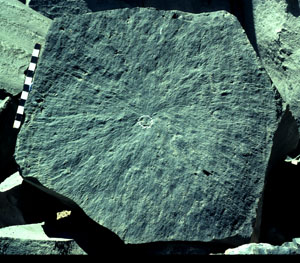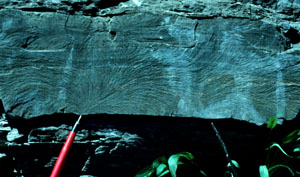|
Initiation points or origins of a plumose structure are commonly marked by geometric or material inhomogeneities, like a cavity (Figure 1), a fossil, an opaque mineral inclusion, or a depositional feature, such as a cusp (Figure 2). These are often referred to as 'flaws' in a mechanical sense. Initiation points are also called the origins which sometimes are captured by naked eye for joints.
 | | Figure 1. Photo showing joint initiation point as well as the radial pattern of the associated plumose structure. The initiation point is a void in the rock due to an air bubble, circled at the center of the photo. From Pollard and Aydin (1988). |
 | | Figure 2. Photo showing joint initiation at a sole mark and the associated plumose structure. Watkins Glen, NY. From Pollard and Aydin (1988). |
| |

